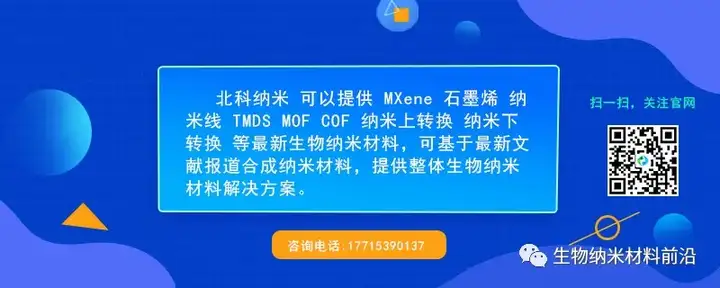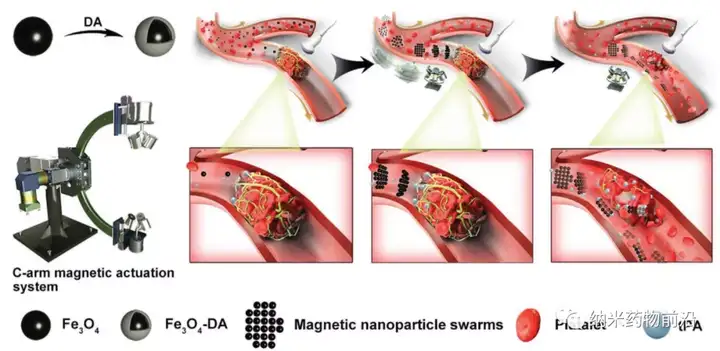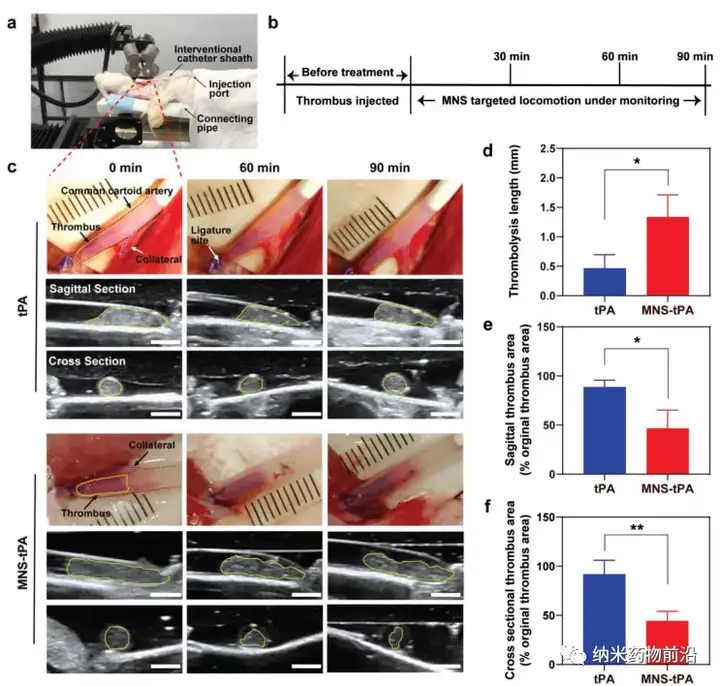Zheng Yuanyi/Wu Jianrong AM: C-arm magnetic control system drives nanocluster to guide drug delivery under video surveillance to enhance thrombolytic therapy

Blood vessel obstruction often leads to many life-threatening symptoms, such as stroke, pulmonary embolism, and organ damage/failure, and may eventually lead to disability or death. Clinically, tissue plasminogen activator (tPA) is mainly used for rapid and effective thrombolytic therapy. However, due to interruption of blood flow and delayed recanalization of blood vessels, the delivery efficiency of thrombolytic drugs is low. Magnetic micro/nano has the advantages of non-invasive, remote control, etc., and is widely used for targeted drug delivery. Existing magnetic micro/nano drugs for targeted thrombosis treatment are limited by the complexity of clinical verification of nano drugs and the limited space of magnetic drive systems. Recently, Professor Zheng Yuanyi (corresponding author) and Dr. Wu Jianrong (corresponding author) of the Sixth People’s Hospital Affiliated to Shanghai Jiaotong University and others have developed a thrombolytic drug delivery strategy based on mass transfer theory and developed a laser positioning and ultrasound imaging guidance. The open space C-arm magnetic control system is used for in vivo evaluation.

The main points of this article: (1) The existing magnetic operating system has limited space or limited magnetic field strength, which is not conducive to in-vivo verification. In order to solve this problem, the research team independently developed a set of ultrasonic monitoring magnetic control device with open space, which can adjust the aggregation of nano-clusters and the movement in different directions to perform appropriate tasks. Its performance is fully verified in vitro and in vivo. (2) Studies have shown that by adjusting the movement of magnetic nanoparticle clusters, tPA can be guided to thrombus through interrupted blood flow based on the theory of mass transfer, thereby improving the efficacy of thrombolysis. In particular, this strategy can quickly establish a life channel to achieve timely recanalization of blood vessels. In vitro and in vivo thrombolytic experiments show that the thrombolytic effect of magnetic nano clusters under the action of rotating magnetic field is significantly improved. In summary, the C-arm magnetic drive system developed in this research provides a tool for in vivo studies of magnetic regulation. Based on this, a clinically feasible targeted thrombolytic therapy strategy is proposed to reduce the systemic circulation of tPA. side effect.

This work has been supported by the National Key Research and Development Program (2018YFC0115200), International Cooperation and Exchange Key Project (81720108023), National Natural Science Foundation Key Project (82030050), Shanghai Science and Technology Plan Project (20JC1419500) and Shanghai Science and Technology Major Technical Special Project ( 2018SHZDZX05) funding. Literature link: https://onlinelibrary.wiley.com/doi/abs/10.1002/adma.202105351
This information is sourced from the Internet for academic exchanges. If there is any infringement, please contact us to delete it immediately
This information is sourced from the Internet for academic exchanges. If there is any infringement, please contact us to delete it immediately
18915694570
Previous: AM cover: New breakthr


